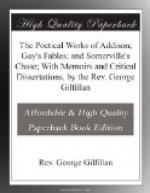We doubt not, however, that, were a genuine poet of this age taking up the “Chase” as a subject for song, and availing himself of the accounts of recent travellers, themselves often true poets, such as Lloyd, Livingstone, Cumming Bruce, and Charles Boner, (see the admirable “Chamois Hunting in Bavaria” of the latter,) he would produce a strain incomparably higher than Somerville’s. Wilson, at least, as we know from his “Christopher in his Sporting Jacket,” and many other articles in Maga, was qualified, in part by nature and in part by extensive experience, to have written such a poem. Indeed, one sentence of his is superior to anything in the “Chase.” Speaking of the charge of the cruelty of chasing such an insignificant animal as a fox, he says, “What though it be but a smallish, reddish-brown, sharp-nosed animal, with pricked-up ears, and passionately fond of poultry, that they pursue? After the first tallyho, reynard is rarely seen till he is run in upon—once, perhaps, in the whole run, skirting a wood, or crossing a common. It is an idea that is pursued on a whirlwind of horses, to a storm of canine music, worthy both of the largest lion that ever leaped among a band of Moors sleeping at midnight by an extinguished fire on the African sands.” We do not answer for the humanity of this description, but it certainly seems to us to exhaust the subject of the chase, alike in its philosophy and its poetry.[1]
SOMERVILLE’S CHASE.
* * * * *




